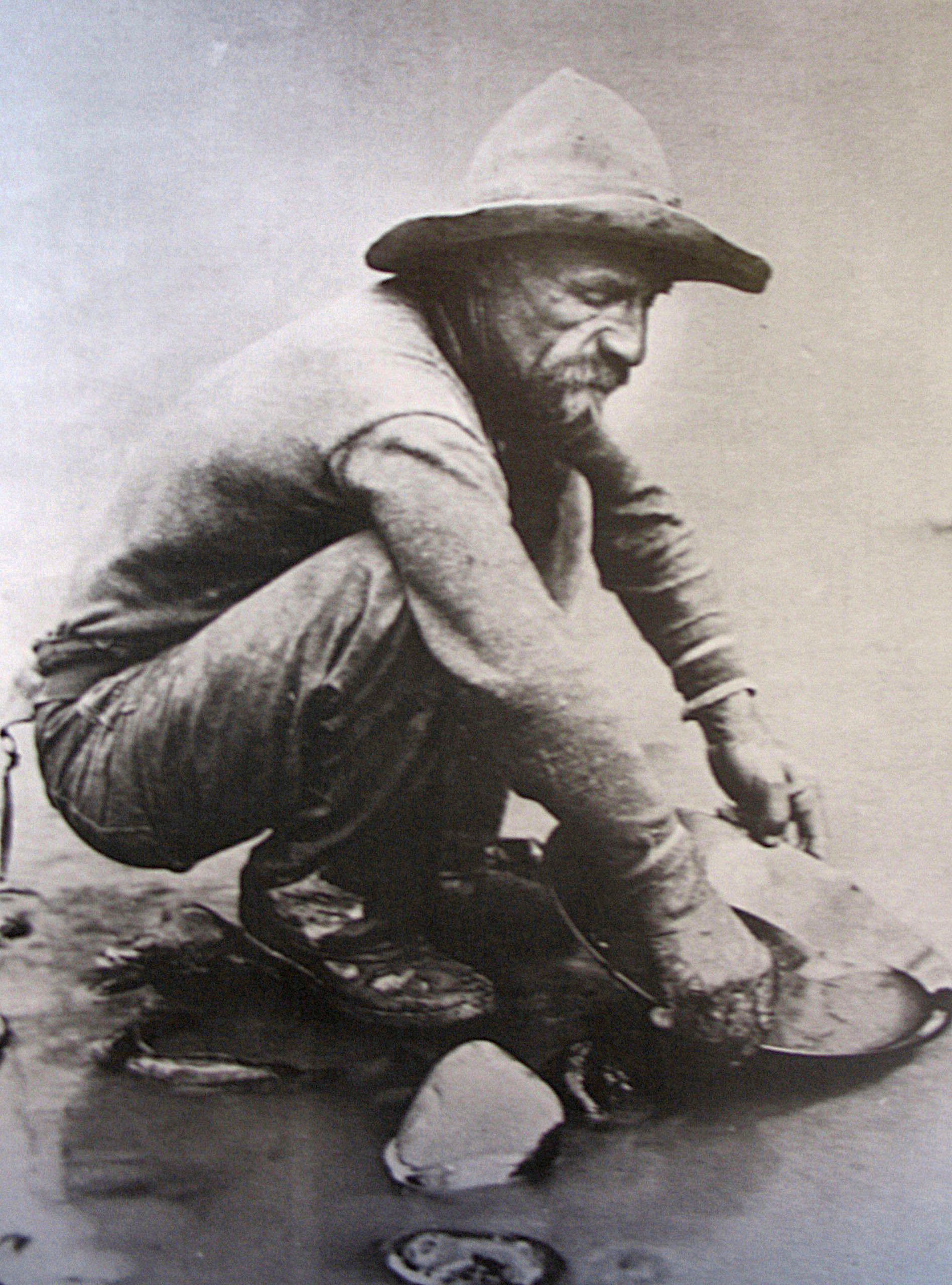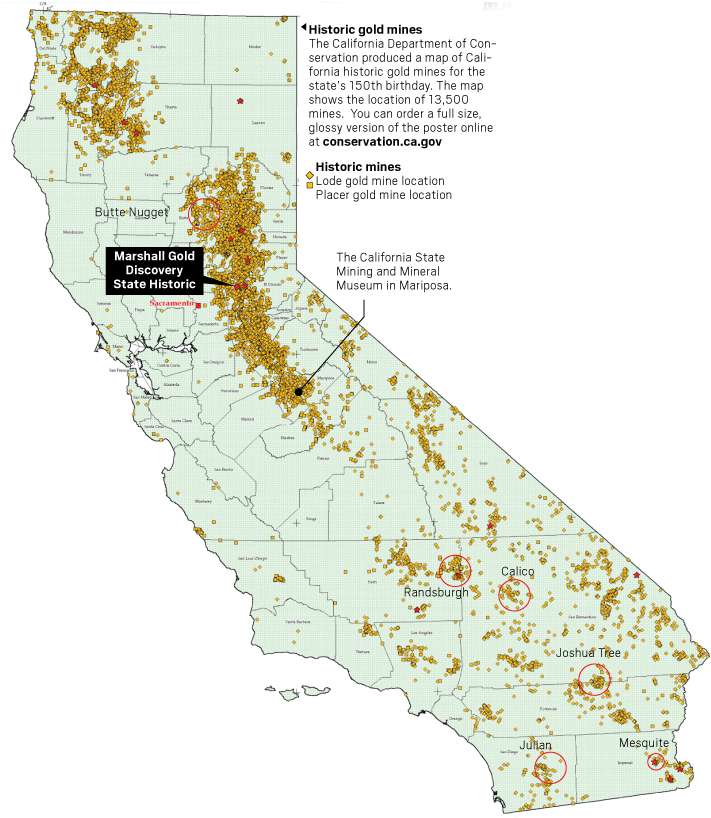Topics on the Page

California Gold Rush
-
The Founding of San Francisco and California
Alaska or Klondike Gold Rush
Lives of Miners
- Multicultural Histories During the Gold Rush
Who Got Rich?
Political Effects
Boom Towns and Ghost Towns
The Search For Gold Today
California Gold Rush
On January 24, 1848 James Marshall and Peter L. Wimmer discovered gold at Sutter's new sawmill on the American River,
setting in motion the California Gold Rush.
Link to brief overview of The Gold Rush on Digital History

 |
| Miners in the Sierras, 1851 |
Sam Brannan printed a page in the California Stardetailing the gold mines in the Sacramento valley attempting to encourage immigration.
News spread rapidly of the gold found in California. People came from as far as China. People were mining as much as $50,000 a day. Mexican migrants, Chilean migrants, Australian migrants, and foreigners from Mexico, Chile and even Australian came to seek their fortune in gold.
At this time, the population of California was estimated at 100,000 including 35,000 people who came by sea, 3000 sailors who deserted ships and 42,000 who came overland. There were some 40,000 people mining in California by the end of 1849.
Gold Rush to 1890s
Map shows historic mine sites and the scale of how many people and how many mines were opened during during the California gold rush.

The Gold Rush Era: 1848-1865
Online exhibits and pictures from the University of California, including
- Murder and Mayhem
- Disasters
- Everyday Life and People
- Growth of Cities
- Environmental Impact
- Diversity in the Changing State
Timeline of the California Gold Rush: https://www.pbs.org/wgbh/americanexperience/features/goldrush-major-strikes-california-gold-rush/
8 Things You May Not Know About the California Gold Rush
Animated video that gives brief overview of the California Gold Rush
The Gold Nugget, an interactive exhibit from the Center for History and New Media at George Mason University.
 The Gold Rush, a documentary on YouTube
The Gold Rush, a documentary on YouTube
https://www.youtube.com/watch?v=iydRkC0gMZI: educational Youtube video
 Click here for journal entries from John Sutter
Click here for journal entries from John Sutter
- For a view of the 25,000 people who came to the gold fiel
 ds by water, see On The Water from the Smithsonian that uses the journals of Alexander Van Valen as key primary sources
ds by water, see On The Water from the Smithsonian that uses the journals of Alexander Van Valen as key primary sources
Food of the California Gold Rush from PBS WGBY57
Alaska or Klondike Gold Rush
Four men working a mining claim at mouth of Last Chance Creek, near Dawson, Yukon Territory, probably between 1898 and 1907

A Map of the Events During the Alaska/Klondike Gold Rush by the NPS
Alaska's Gold - An interactive website from the Alaska Department of Education
Klondike Gold Rush: The Perilous Journey North, University of Washington Libraries
What Was the Klondike Gold Rush?
Dawson City, the gold rush town, had a historical treasure of more than 500 forgotten silent films buried in permafrost for decades until 1978. View the video here:
 Dawson City: Frozen Time Official Trailer
Dawson City: Frozen Time Official Trailer
 The Klondike Gold Rush
The Klondike Gold Rush
 Mini-Biographies of the "Klondike Kings"
Mini-Biographies of the "Klondike Kings"
In August 1896 when Skookum Jim Mason, Dawson Charlie and George Washington Carmack found gold in a tributary of the Klondike River in Canada's Yukon Territory, they had no idea they they would set off one of the greatest gold rushes in history. Beginning in 1897, an army of hopeful gold-seekers, unaware that most of the good Klondike claims were already staked, boarded ships in Seattle and other Pacific port cities and headed north toward the vision of riches to be had for the taking. (National Park Service)
Approximately 70,000 "stampeders" trekked their way up the passes through Dawson, Skagway, and Dyea between the years of 1896 and 1898. These towns were made up of tent clusters, many of which were abandoned by the end of the century. This brief moment in history is known as the "Last Great Adventure of the Nineteenth Century."
- Rejuvenation of Seattle
- After a large fire burned down the city's commercial district in 1889, the city was in need of help. In 1897, when the papers with headlines exclaiming the gold found in the Klondike region, the city found the help it needed. Merchants in the city claimed Seattle was the "Gate to the Goldfields."
- Read more about the relationship between Seattle and the Goldfields here.
Read about the significant events of the Klondike Gold Rush, including the Deadly Palm Sunday Avalanche, here.
Lives of the Miners
Resources on the gold rush. Includes reading letters from people who took part in the gold rush.

The process and lifestyle surrounding panning for gold created communities throughout the goldfields of the West. Those who traveled to California in the search for gold were later known as 49er's. The 49er's often left their homes back East and settled in crowded, lawless mining camps.
Multiculturalism During the Gold Rush
During this period immigrants from all over came to the West to profit from the Rush. When they arrived, miners lived within communities of their own race.
In CALIFORNIA
- Immigrants from China made up 1/5 of the population in CA by the end of the 1850s. They were met with racism and were often the victims of the many robberies and murders that happened.
- Read more about the experiences of Chinese immigrants here
- African Americans came to California as both slaves and freed men. Their presence in the territory became a tipping point in the debate of whether CA would be a free state or not.
- Californios were the Mexicans living in CA who became naturalized citizens after the Mexican American War (1846-1848). During the Gold Rush, this population was targeted by the Foreign Miners Tax; a tax that successfully kept the Californios from profiting.
Women in the California Gold Rush
- The self-sufficient and semi-nomadic Native tribes in Yukon territory were also greatly effected by the incoming of European stampeders during the Klondike Gold Rush
Effects on the Environment
The discovery of gold in CA led to the destruction of the hillsides of the Sierra Nevada mountains and building of mines within them.
Eventually, the agriculture industry in CA outran the mining industry in terms of productivity which shifted the region's economy.
Native American tribes were dramatically effected when european settlers moved west, and the Gold Rush worsened those effects
Who Got Rich?

While only a few lucky men made fortunes from the finding of gold, most of the money was made by merchants who sold the miners overpriced food and goods.
Political Effects
- the dispute over California's entrance to the Union as a free state or a slave state
- Social politics that affected how different ethnicities were treated for years to come
- treatment of Mexican Americans by European Americans
Boom Towns and Ghost Towns
Many towns and cities across the U.S were built on the footprint of settlements built for settlers in search of economic opportunity. However, many were forgotten as the economic value of their commodities shifted, or, in this case, when the mines and rivers were emptied of gold.
- San Francisco, California
The Search for Gold Today
The California Drought Brings Back Gold Fever
 Quiz Question:
Quiz Question:
How did the California Gold Rush contribute to California’s admittance into the Union as a state?
Answer: True- the gold rush gave California a huge population boom with many economic interests to the United States so they were quickly admitted into the union as a free non-slavery state.
Comments (0)
You don't have permission to comment on this page.